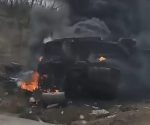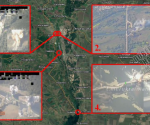In the suburbs of Kupyansk
Those people who think that Putin and Russian Government is an agency for the City of London in the implementation of its New World Order will probably think that the Russian supremacy on the Ukrainian battlefield in stand-off firepower, so that the destruction of Ukrainian forces is such that allied militaries have to supplement them with equipment from their own precious stocks, is merely a scheme for the benefit of Western military industrial complexes from whom replacements must be procured.
That’s all very well as an explanation when the Czech Republic, for instance, is swapping old Soviet models for (not necessarily better) American versions, but it doesn’t make any sense when so-called modern Western equipment is being taken from its in-service usage by Western militaries at a rate that outstrips capacity to produce substitution. It doesn’t make sense when base industrial capacity does not in fact exist to provide the necessary capability, and when it is not clear, down the line, how the procurement is to be paid for (at the risk of causing perilous levels of domestic political instability as military budgets are preferred over welfare ones). It certainly doesn’t make sense when reputations are ruined as images of shattered Western “wunderwaffe” are plastered all over the globe via the internet and seen to be so much junk. Sales figures will definitely not benefit from such armament becoming exhibits in countless Russian museums as examples of “wunderwaffe” that didn’t change the game after all.
Let us go over this again.
Prior to 2022 Ukraine was armed to the teeth by the West ($2.5 billion in military aid from the US alone) – on top of its significantly large Soviet era stock – in order to launch an attack to retake the Novorossiyan republics and possibly also Crimea. Western sponsors thought that enough had been done. At the outbreak of the Special Military Operation, and after Russia destroyed this first iteration of Ukrainian military might, there was mobilisation, the activating of reservists, the provision of ordnance packages from foreign sponsors and a cobbling together of a “million man” army that would be wasted in a Human Wave against the Russians in Kharkov, Kherson and Zaporozhe, taking advantage (or so it was thought) of the Russian requirement to effect a mobile defence. The waste happened, of course, but the objectives were not met.
So at this present time, the bottoms of barrels are being scraped. Ukrainians are mobilised by being forcibly dragged from the streets where they are press-ganged, and while wheeled/tracked armour is plenty for running the gauntlet of Russian artillery at speeds greater than marching pace, excuses are being made for not sending the actual tanks as promised; the idiot Wallace of the UK Ministry of Defence, for instance: “the politicians sent their military to the depots only to find that their tanks are not operational or repaired for delivery to Ukraine”. The vested interests can’t afford to have them sent, more like. Some incredible temporary embarrassment is worth the long-term face saving, it seems, as The Times reports “Kyiv [sic] is expecting its supporters to send up to 320 western tanks in total but estimates suggest barely 50 will reach the front lines by the start of April”.
From the so-called Munich Security Conference, which was essentially a public relations platform being held this last week from which the West could exercise its bark about a less impressive bite, a Financial Times correspondent had all this covered. His headline: “A year of war in Ukraine has left Europe’s armouries dry”, with sub-headline: “Reality of sustaining Kyiv’s [sic] army through a long, bloody conflict is dawning on the west”, and sub-text: people with power and fortune to retain don’t want to be found out as being fraudulent and weak.
But in many capitals, defence ministers are being informed by their generals that there is precious little left to give. Warehouses and dumps are bare. Denmark has given Ukraine every single one of its Caesar howitzers. Estonia has provided so many 155mm artillery guns it has none left.
As such, the conversations between western defence ministers who met at Nato’s headquarters this week and who will congregate at the Munich Security Conference this weekend are littered with furrowed brows and anxious looks: how long can we sustain this level of support, and with what?
Looming over them is Russia’s spring offensive, which Stoltenberg said had already begun. It is expected to involve a mass wave of newly mobilised troops, a level of air power not yet deployed by Moscow, and the daily firing of as many artillery shells as Europe manufacturers in a month.
“It is worrying what is coming,” admitted Kajsa Ollongren, the Netherlands’ defence minister.
She described “a sense of urgency” among her fellow Nato ministers this week. “[It is] a critical moment because of what we see happening on the ground and what we expect to be happening in the next few months.”
Now, what the reader is asked to notice is the connection between realities on the ground and the problems of provision. Note, the recognition of a current Russian offensive. Note the perturbation.
This is the point: when UK/US planners were heeding the Ukrainian General Zaluzhny’s pitch for continuing in 2023 the Human Wave attacks of 2022†, and when they were believing their own propaganda about Russian winter inertia, there was none of this generals discovering bare cupboards nonsense. You see, reader, when it appeared that the sacrifice would yield a result, under the cover of which deficiency could be hidden, there was no indication that provision to Ukraine would present a problem. Now, on the other hand, with Russia spoiling the prospect of a mad dash to a supposed finish line‡ by attriting Ukrainian forces and, even worse, advancing to capture Ukrainian territory and everything that might be abandoned within it, there is not one hen amongst all the chickens that does not threaten to come home to roost. All the eggs, to continue the theme, must not be risked in the one basket.
Of course, this is not to say that there isn’t a problem with materially sustaining Ukrainian forces to maintain a longer haul defensive fight, at the root of which is the fact of the very real degradation of Ukrainian ammunition stocks (and the always undisclosed reason for this was explained in the article, What The Russian Religious Holiday Ceasefire Told Us About Ukrainian Artillery And Therefore Alternative Media (As We Should’ve Already Known)). If the current situation is concerning for Ukraine’s sponsors in this respect now, as the Dutch defence minister declares, expectations for the future must be causing great anxiety.
But don’t expect the UK/US to extrapolate Ukraine’s defeat from any dawning realisation that is supposed to be happening – not one that happens in the realm of it public relations, at least.
As for events on the ground, one of those that Kajsa Ollongren might be expecting in the next few months is the Russians making it untenable for the Ukrainians to maintain a presence in that part of Kharkov which is east of the Oskil River. This could then allow the Russians to consolidate – or even create it if there is current content to hold the Ukrainians on the Lugansk border – the northern jaw around its Donetsk operations.
In recent days the Russians have announced the liberation of the settlement of Grianikovka which, with the preceding capture of Dvurechnoye, effectively seals the eastern bank of the Oskil in that vicinity. If it is the Russian intention to move southwards along the river, there are a few settlements that might fall as a matter of course by dint of being isolated from Kupyansk, which is where the next river crossing occurs. Indeed, a Ukrainian report of 18th February, in the usual way such things are framed, told of the “repelling” of a Russian attack on Sinkovka (“Sin’kivka”).
About 5 miles from Kupyansk, Sinkovka’s relation to that city can be best appreciated in a satellite view obtained from Googlemaps (above), where its being an outlying part of a conurbation involving Kupyansk becomes quite evident. Sinkovka’s position in relation to a frontline translated from Russian MoD map (on 14th February) is shown below. As suggested in the piece for which the map was originally created (The End Of The “Battle Of The ‘Svatove–Kreminna’ Line”), the line shouldn’t be taken as a definite indicator of the extent of Russian progress into Ukrainian positions – not least because we are hearing about direct attacks on Sinkovka.
Update, 21st February, 2023:
On this date, the Russian Ministry of Defence reports “the active operations, conducted by the units of the ‘Zapad’ Group of Forces, supported by Army Aviation and artillery, have resulted in the neutralisation of the units of the Armed Forces of Ukraine (AFU) near… Sinkovka” (amongst other places).
† See, The Offensive That Isn’t On 17th December: Russian Activity In The Kupyansk And Krasny Liman Directions (link)
‡ See, The Russian Offensive (link)




















